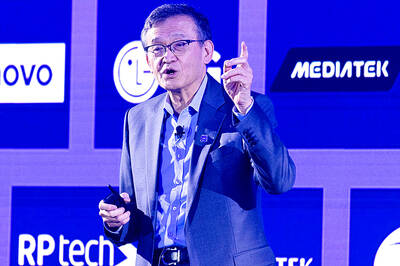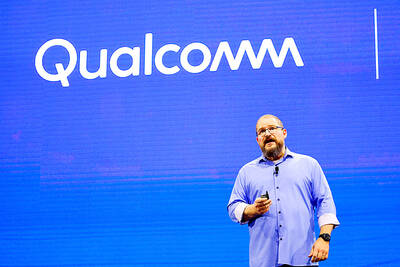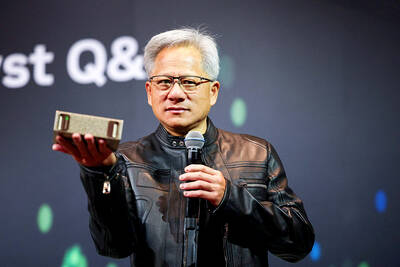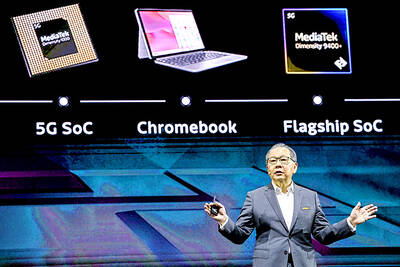Clutching a fistful of shopping bags from designers Vivienne Westwood, Dior and Alexander McQueen, 29-year-old Zhao Bing prowled an upscale department store.
“Is there a financial crisis in China? I don’t think it has affected my life very much,” said Zhao, who spent 7,000 yuan (US$1,000) in 90 minutes at Lane Crawford in Beijing’s financial district on what she said was a twice-monthly shopping spree last week. “I still buy those big brands, any one you could think of.”
Some well-heeled Chinese shoppers like Zhao, a film technician who gets an allowance from her parents on top of her salary, are spending freely during the global economic crisis. High-end designers and luxury retailers that thrive on such extravagance are looking to them to drive sales as demand in other countries collapses.
China’s 6 billion euro (US$8 billion) luxury market accounts for just 3 percent of global sales, but China and Brazil are projected to be the two fastest-growing luxury markets for the five years through 2012, consulting firm Bain & Co said.
China’s sales of designer clothing, jewelry and other goods will climb 7 percent this year, while the industry’s worldwide revenue could fall 10 percent, Bain & Co forecast. Last year, luxury sales in China surged 25 percent, while global growth was zero.
Just as more mainstream brands like Starbucks Corp and Yum Brands Inc’s KFC are expanding fast in China, higher-end brands such as Salvatore Ferragamo and Gucci are adding stores there while other retailers have postponed or limited expansion in listless US, European and Japanese markets.
“The China market is growing fast. Beside the global downturn which affects every country, China is quite stable,” Michele Norsa, chief executive of Salvatore Ferragamo SpA, said in an e-mail response to questions. “Definitively, we are optimistic.”
Ferragamo plans to add seven to eight Chinese stores this year, with further expansion next year, Norsa said.
Gucci Group, part of France’s PPR SA, plans to open a flagship store in Shanghai this month after adding three new locations in January. It says its sales in China soared 42 percent last year compared with 2007, 10 times its global growth rate of 4.2 percent.
Gucci said China currently represents one of its most dynamic areas of retail growth. Greater China including Hong Kong and Macau accounted for 14.3 percent of Gucci’s sales last year.
France’s Domaines Barons de Rothschild, producer of Chateau Lafite wine, is developing a vineyard in Shandong Province to serve growing local demand.
China’s luxury shoppers are strikingly young, many of them self-employed or part of a growing professional class. Consulting firm McKinsey & Co said 80 percent were under 45, compared with 30 percent of luxury shoppers in the US and 19 percent in Japan.
Liu Hongyan, a 34-year-old marketing director for a culture magazine in Chengdu, Sichuan Province, just bought a Coach purse to replace her Chanel, two necklaces and a bracelet from Tiffany and some Estee Lauder cosmetics.
“Like many of my friends, my job is stable and not affected by the financial crisis,” she said. “Now that we are finished buying apartments and cars, we are buying luxury goods.”
Growth in China may not be huge in dollar terms, but it helps counter sales declines elsewhere, says Claudia D’Arpizio, a Bain partner in Milan.
“It’s not enough for offsetting completely the stronger decrease in the US, Japan and Europe,” she said.
Fueled by a three-decade-old economic boom that created a still-growing urban elite, China’s appetite for luxury goods is surviving the sharpest global economic slump since the 1930s. But Beijing’s multibillion-dollar stimulus plan appears to be reviving the economy. Recent reports show gains in factory output, retail sales and capital investment.
China’s luxury market is still modest, compared with Europe’s, which accounts for 38 percent of worldwide spending on luxury goods, South and North America’s at 33 percent and Japan’s 12 percent, D’Arpizio said.
By 2015, China will have more than 4 million households with annual income above 250,000 yuan (US$37,000), McKinsey predicted in a recent report. That will make it the world’s fourth-largest country in terms of its number of households with substantial purchasing power after the US, Japan and the UK.
McKinsey said the benchmark was adjusted for purchasing power parity for each country.
And most of that money likely will be spent in China. McKinsey said its research found wealthy Chinese do 70 percent of their luxury spending at home, contrary to the industry wisdom that Chinese people make at least half their purchases abroad.
“We know Chinese consumers will continue to spend on luxury items,” Norsa said. “After all, it is a very big pond and in it there is space for many.”
Companies are expanding inland to cities like Chengdu to reach customers “who can already afford and who will aspire to the image projected by luxury brands,” D’Arpizio said.
Many Chinese, of course, can’t afford these brands and opt for knock-offs. From fake Gucci wallets to Chanel bags, they are widely available despite repeated government crackdowns. Some are so well-made that only experts can spot them.
Wu Yang, a 25-year-old Beijing event planner, bought counterfeit Louis Vuitton and Gucci bags on a recent trip to Shanghai. She said vendors wanted between 300 yuan and 500 yuan for a bag, compared with between 5,000 yuan and 10,000 yuan for the real thing.
Her next goal: the latest counterfeit Balenciaga bag.
“I can afford it and nobody can tell it’s not real,” Wu said. “This represents a girl’s dream for big brands.”

Intel Corp yesterday reinforced its determination to strengthen its partnerships with Taiwan’s ecosystem partners including original-electronic-manufacturing (OEM) companies such as Hon Hai Precision Industry Co (鴻海精密) and chipmaker United Microelectronics Corp (UMC, 聯電). “Tonight marks a new beginning. We renew our new partnership with Taiwan ecosystem,” Intel new chief executive officer Tan Lip-bu (陳立武) said at a dinner with representatives from the company’s local partners, celebrating the 40th anniversary of the US chip giant’s presence in Taiwan. Tan took the reins at Intel six weeks ago aiming to reform the chipmaker and revive its past glory. This is the first time Tan

Qualcomm Inc is strengthening its partnerships with Taiwan Semiconductor Manufacturing Co (TSMC, 台積電) and original design manufacturers (ODMs) in Taiwan as it expands its presence in the artificial intelligence (AI) computer market, CEO Cristiano Amon said in Taipei yesterday ahead of the annual Computex trade show. “Historically we’ve always been a very big customer of TSMC, and we continue to be,” Amon said during a media Q&A session. “For chip manufacturing, we’re among the largest fabless [semiconductor designers],” he said, noting that Qualcomm, a leading provider of mobile and AI-enabled chipsets, ships about 40 billion components every year, with TSMC being

‘FAILED EXPORT CONTROLS’: Jensen Huang said that Washington should maximize the speed of AI diffusion, because not doing so would give competitors an advantage Nvidia Corp cofounder and chief executive officer Jensen Huang (黃仁勳) yesterday criticized the US government’s restrictions on exports of artificial intelligence (AI) chips to China, saying that the policy was a failure and would only spur China to accelerate AI development. The export controls gave China the spirit, motivation and government support to accelerate AI development, Huang told reporters at the Computex trade show in Taipei. The competition in China is already intense, given its strong software capabilities, extensive technology ecosystems and work efficiency, he said. “All in all, the export controls were a failure. The facts would suggest it,” he said. “The US

NEW PRODUCTS: MediaTek has been diversifying its product lines to minimize operational risks as mobile chips remain the company’s biggest revenue source MediaTek Inc (聯發科), the world’s biggest supplier of smartphone chips, yesterday said the tape-out process for its first 2-nanometer chip would take place in September, paving the way for volume production of its most advanced chip, likely to be its next-generation flagship smartphone chip, around the year-end at the earliest. MediaTek has been leveraging advanced process technologies from its foundry partner, Taiwan Semiconductor Manufacturing Co (TSMC, 台積電), to build its flagship mobile phone chips, a segment it once relinquished and then recovered four years ago as it released its Dimensity series. In the semiconductor industry, a tape-out refers to the